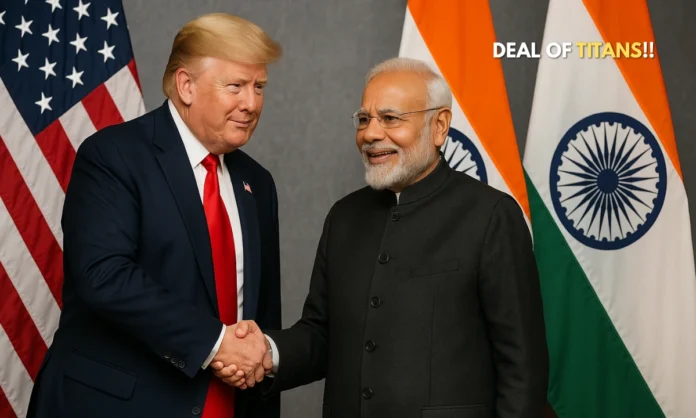Key Highlights
- US President Donald Trump confirmed during his Asia tour that a long-delayed US India trade deal will be signed soon
- The US agreed to reduce tariffs to 16% after India indicated it would scale back Russian oil purchases from current 34% import share
- Bilateral trade between the two nations reached a record $212.3 billion in 2024, with both countries targeting $500 billion by 2030
Opening Overview
President Donald Trump’s announcement during his South Korea visit has brought the protracted US India trade deal negotiations to the forefront of international economic discussions. Speaking at the Asia-Pacific Economic Cooperation Summit, Trump declared his intention to finalize the US India trade deal, expressing “great respect and love” for Prime Minister Narendra Modi while emphasizing their “great relationship.”
This development marks a significant breakthrough in talks that have been stalled for months over contentious issues including India’s Russian oil imports, agricultural market access, and punitive US tariffs. The US India trade deal represents more than just a bilateral agreement between two economic powerhouses – it signifies a potential reshaping of global trade dynamics as both nations work toward doubling their current trade volume to $500 billion by 2030.
The fact that he thinks India is working on oil, and is okay with russia ukraine fight means that US-India trade deal is near. pic.twitter.com/dj9sOcFfiG
— Jack Rangaswami (@JackRangaswami) October 30, 2025
Progress on Key Trade Barriers
The path to finalizing the US India trade deal has been marked by significant diplomatic breakthroughs in recent weeks. According to official sources, the United States has agreed to reduce its punitive tariffs on Indian goods from the current 50% to approximately 16%, following India’s commitment to scale back its Russian oil purchases. This represents a major concession from Washington, which had imposed a 25% penalty tariff specifically targeting India’s energy imports from Russia, arguing that such purchases were “fueling the Ukraine war.”
- The US currently imports goods worth $87.3 billion from India annually, making it India’s largest trading partner
- India’s Russian oil imports account for 34% of total crude imports as of September 2025
- Both nations are targeting completion of the first tranche of their Bilateral Trade Agreement (BTA) by November 2025
The US India trade deal negotiations have gained momentum following productive discussions between trade representatives in Washington earlier this month, with sources indicating that negotiators have reached consensus on “most issues” and are now focusing on finalizing the legal language of the agreement. External Affairs Minister S. Jaishankar and US Secretary of State Marco Rubio recently met in Kuala Lumpur to further advance these critical trade discussions.
Agricultural Market Access Breakthrough
A cornerstone of the US India trade deal involves resolving long-standing disputes over agricultural market access, particularly regarding US corn and soybean exports to India. The United States has been pressing India to allow imports of non-genetically modified American corn for ethanol production and soybean meal for livestock feed, arguing that these products would not compete directly with Indian farmers. Industry sources suggest that India may consider partial imports of these commodities as part of the broader US India trade deal framework, despite resistance from domestic agricultural producers who fear market disruption.
- US soybean farmers are seeking new markets after China imposed retaliatory tariffs during the US-China trade war
- India maintains the world’s largest cattle herd, creating substantial demand for protein-rich animal feed
- The compromise could include periodic review mechanisms for tariffs and market access provisions
The agricultural component of the US India trade deal reflects broader geopolitical dynamics, as the Trump administration seeks to redirect agricultural exports away from China toward more reliable partners. For India, accepting limited agricultural imports represents a strategic trade-off to secure reduced tariffs on its manufactured goods, particularly in labor-intensive sectors like textiles, gems, jewelry, and seafood that employ millions of workers.
Economic Impact and Market Response
Financial markets have responded positively to prospects of an imminent US India trade deal, with analysts projecting significant benefits for Indian exporters across multiple sectors. Investment firm Nomura estimates that successful completion of the trade agreement could result in a 25% tariff reduction after November, providing substantial relief to Indian manufacturers facing the current 50% levy. The US India trade deal is expected to particularly benefit textile, automotive parts, pharmaceutical, and information technology services sectors, which constitute major components of India’s export portfolio to the United States.
- Total US-India goods and services trade reached $212.3 billion in 2024, up 8.3% from the previous year
- India maintains a trade surplus of $41.18 billion with the United States in fiscal year 2024-25
- The agreement aims to more than double bilateral trade to $500 billion by 2030
Recent data from the US Trade Representative office confirms that bilateral trade momentum has continued despite tariff pressures, with US goods imports from India totaling $87.3 billion in 2024, representing a 4.5% increase from 2023. The US India trade deal is positioned to unlock this potential further by removing artificial barriers that have constrained trade growth between the world’s largest and fastest-growing major economies.
Closing Assessment
The impending US India trade deal represents a watershed moment in US-India economic relations, potentially transforming one of the world’s most important bilateral trade partnerships. Trump’s confident assertion that the agreement will be signed soon reflects the substantial progress made in resolving complex issues that have plagued negotiations for months.
With both nations committed to achieving $500 billion in annual trade by 2030, the US India trade deal serves as more than an economic agreement – it establishes a foundation for deeper strategic cooperation between democratic allies in an increasingly multipolar world. The successful resolution of disputes over Russian oil imports and agricultural market access demonstrates that pragmatic diplomacy can overcome even the most challenging trade barriers, setting a precedent for future US India trade deal negotiations across additional sectors and creating a model for comprehensive bilateral economic partnerships in the 21st century.


